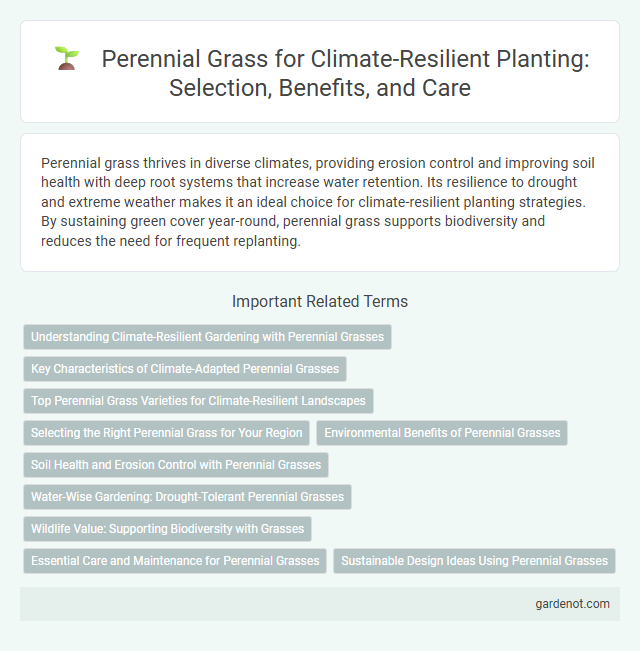Perennial grass thrives in diverse climates, providing erosion control and improving soil health with deep root systems that increase water retention. Its resilience to drought and extreme weather makes it an ideal choice for climate-resilient planting strategies. By sustaining green cover year-round, perennial grass supports biodiversity and reduces the need for frequent replanting.
Understanding Climate-Resilient Gardening with Perennial Grasses
Perennial grasses enhance climate-resilient gardening by promoting soil stability and reducing erosion through their deep root systems. Their ability to withstand drought and extreme weather conditions makes them ideal for sustainable landscaping and carbon sequestration. Integrating diverse perennial grass species improves ecosystem resilience and supports biodiversity in changing climates.
Key Characteristics of Climate-Adapted Perennial Grasses
Climate-adapted perennial grasses exhibit deep root systems that enhance soil moisture retention and improve erosion control in drought-prone areas. These grasses demonstrate high tolerance to temperature fluctuations and variable precipitation, enabling sustained growth under extreme weather conditions. Their ability to sequester carbon effectively contributes to reducing greenhouse gas concentrations while supporting ecosystem resilience.
Top Perennial Grass Varieties for Climate-Resilient Landscapes
Top perennial grass varieties for climate-resilient landscapes include Switchgrass (Panicum virgatum), known for its deep root system and drought tolerance, Big Bluestem (Andropogon gerardii), which thrives in both wet and dry conditions, and Buffalo Grass (Bouteloua dactyloides), valued for its low water requirements and heat resistance. These grasses enhance soil stability, improve carbon sequestration, and reduce erosion, making them ideal for sustainable land management in changing climates. Their ability to adapt to extreme weather patterns supports biodiversity and long-term ecosystem resilience.
Selecting the Right Perennial Grass for Your Region
Selecting the right perennial grass for your region requires understanding soil type, climate conditions, and drought tolerance to ensure long-term resilience and minimal maintenance. Native species like big bluestem, switchgrass, and Indian grass are highly adapted to local environments and improve soil stability while enhancing biodiversity. Integrating climate-smart selections boosts carbon sequestration, reduces erosion, and supports sustainable landscapes in changing weather patterns.
Environmental Benefits of Perennial Grasses
Perennial grasses contribute to climate resilience by enhancing soil carbon sequestration and reducing greenhouse gas emissions through their deep root systems. They improve soil structure and water retention, mitigating erosion and supporting biodiversity in agricultural landscapes. These grasses also stabilize ecosystems by providing continuous ground cover, which helps regulate microclimates and buffer against extreme weather events.
Soil Health and Erosion Control with Perennial Grasses
Perennial grasses enhance soil health by improving organic matter content and promoting beneficial microbial activity, which increases nutrient cycling and soil structure stability. Their deep, fibrous root systems anchor the soil, significantly reducing erosion caused by wind and water. This natural erosion control not only preserves topsoil but also maintains watershed quality, supporting long-term agricultural productivity and climate resilience.
Water-Wise Gardening: Drought-Tolerant Perennial Grasses
Drought-tolerant perennial grasses, such as buffalo grass and blue grama, play a crucial role in water-wise gardening by reducing irrigation needs and enhancing soil moisture retention. These grasses exhibit deep root systems that improve drought resilience and prevent soil erosion in arid landscapes. Incorporating species like fountain grass and switchgrass supports sustainable landscaping while conserving water resources in climate-resilient planting designs.
Wildlife Value: Supporting Biodiversity with Grasses
Perennial grasses provide critical habitat and food sources for a variety of wildlife, enhancing ecosystem biodiversity. Their deep root systems improve soil health and water retention, creating stable environments for insects, birds, and small mammals. Incorporating diverse perennial grass species in planting projects supports resilient ecosystems and promotes sustainable wildlife populations.
Essential Care and Maintenance for Perennial Grasses
Perennial grasses require well-drained soil and consistent moisture during the establishment phase to develop deep root systems essential for climate resilience. Regular mowing at the appropriate height prevents stress and encourages density, while periodic fertilization tailored to species-specific nutrient needs supports sustained growth and durability. Monitoring for pests and diseases ensures early intervention, maintaining plant health and maximizing the carbon sequestration potential of perennial grass stands.
Sustainable Design Ideas Using Perennial Grasses
Perennial grasses offer exceptional climate resilience by enhancing soil stability, improving water retention, and reducing erosion, making them ideal for sustainable landscape design. Species like switchgrass (Panicum virgatum) and big bluestem (Andropogon gerardii) thrive in diverse climates and require minimal irrigation once established, lowering maintenance costs and conserving water resources. Integrating these grasses into urban green spaces and restoration projects supports biodiversity while contributing to carbon sequestration and long-term ecosystem health.
Perennial grass Infographic

 gardenot.com
gardenot.com